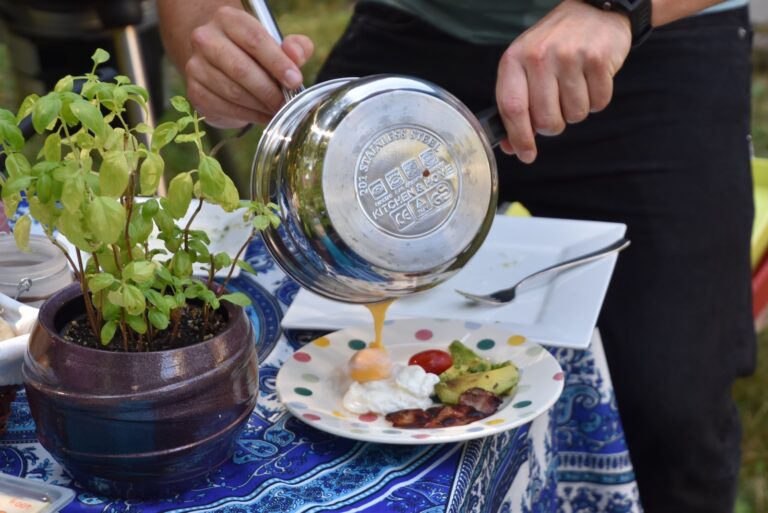I’ve always wondered if it’s possible to bake a cake in a glass pan. So, I decided to dive into the topic and find out the pros and cons of using glass pans for baking.
In this article, we’ll explore the science behind glass pan baking, share tips and tricks for achieving a perfect cake, discuss how to adjust baking times and temperatures, and even delve into different types of glass pans available.
Let’s discover if glass pans are the secret ingredient to baking success!
Key Takeaways
- Glass pans provide even heat distribution, resulting in evenly baked cakes.
- Glass pans are non-reactive and won’t interact with acidic ingredients.
- Glass pans are more prone to breaking when exposed to sudden temperature changes.
- Adjusting oven temperature and baking time is crucial when using a glass pan.
The Pros and Cons of Baking a Cake in a Glass Pan
Baking a cake in a glass pan can have its pros and cons. Understanding the benefits of using a glass pan is important when deciding whether to bake your cake in one.
One advantage is that the glass allows for even heat distribution, resulting in a more evenly baked cake. Additionally, glass pans are non-reactive, meaning they won’t interact with acidic ingredients like metal pans might. This can be especially beneficial for recipes that include fruits or citrus flavors.
However, there are also potential drawbacks to consider. Glass pans can take longer to heat up compared to metal pans, which may affect baking time and result in an undercooked or overcooked cake. Furthermore, glass pans are more prone to breaking if exposed to sudden temperature changes.
Understanding the Science Behind Glass Pan Baking
When it comes to baking, understanding the science behind heat distribution in glass pans is crucial.
Glass has unique properties that impact how heat is distributed throughout the pan and ultimately affects the outcome of your baked goods.
In this discussion, I will explore the advantages of using glass pans for baking and how they can contribute to a better overall baking experience.
Heat Distribution in Glass
To ensure even heat distribution in a glass pan, you should preheat the oven before placing the cake inside. This is because glass has lower thermal conductivity compared to other materials like metal. Heat transfer in a glass pan occurs through conduction, where heat energy is transferred from the hot air in the oven to the surface of the pan and then to the batter. However, due to its low thermal conductivity, glass takes longer to heat up and distribute heat evenly throughout its surface. Preheating the oven helps to minimize temperature differences between different areas of the pan and ensures that your cake bakes evenly.
| Area | Thermal Conductivity |
|---|---|
| Glass | Low |
| Metal | High |
| Ceramic | Medium |
Therefore, if you want your cake to bake properly in a glass pan, it’s important to allow sufficient time for preheating and ensure even heat distribution throughout the baking process.
Advantages of Glass Pans
Glass pans have the advantage of providing a more even distribution of heat during the baking process. This is one of the main benefits of using glass pans for baking. When I bake cakes in glass pans, I notice that they come out perfectly cooked every time. The heat is evenly distributed throughout the pan, ensuring that the cake bakes evenly and doesn’t have any hot spots or areas that are undercooked.
Another advantage of using glass pans is their versatility. They can be used for both sweet and savory dishes, making them a great investment for any kitchen. Plus, glass pans are easy to clean and dishwasher safe, which makes cleanup a breeze.
Overall, I highly recommend using glass pans for all your baking needs due to their numerous advantages and benefits.
Tips and Tricks for Baking a Perfect Cake in a Glass Pan
If you’re using a glass pan to bake a cake, make sure to adjust the oven temperature and baking time accordingly. Glass pans conduct heat differently than metal pans, so it’s important to understand how this can affect your cake.
Here are some tips and tricks for baking a perfect cake in a glass pan:
- Lower the oven temperature by 25 degrees Fahrenheit (or 15 degrees Celsius) compared to what the recipe suggests. This will help prevent the edges of the cake from over-browning.
- Increase the baking time slightly. Glass pans take longer to heat up, so you may need to add a few extra minutes to ensure that the center of your cake is fully cooked.
- Grease and flour your glass pan thoroughly before adding the batter. This will help prevent the cake from sticking and ensure easy removal.
- Allow your cake to cool completely in the pan before attempting to remove it. This will prevent any potential sticking or crumbling when transferring it onto a serving plate.
Adjusting Baking Times and Temperatures for Glass Pan Baking
When it comes to baking in a glass pan, understanding heat distribution is key. Glass pans tend to conduct heat differently than metal pans, which can affect the overall baking time and temperature needed for your recipe.
In this discussion, I will explore the importance of adjusting baking times and temperatures when using a glass pan, ensuring that your baked goods come out perfectly every time.
Glass Pan Heat Distribution
The heat in a glass pan is distributed evenly, resulting in a perfectly baked cake. This is why I always prefer using a glass pan for my baking needs. Here are four reasons why glass pans are so effective:
- Glass conducts heat more efficiently than metal pans, ensuring that the cake bakes evenly from all sides.
- The transparent nature of the glass allows you to monitor the browning process and prevent over-baking or burning.
- Glass pans retain heat better than other materials, which means your cake will stay warm for longer after it’s taken out of the oven.
- Glass can withstand high temperatures without warping or bending, making it a durable option for baking.
When using a glass pan, it’s important to note that the temperature and baking time may need slight adjustments compared to traditional metal pans. However, once you get the hang of it, you’ll find that baking in a glass pan yields consistently delicious results every time!
Adjusted Baking Time
Remember to adjust the baking time according to the recipe instructions for metal pans, since glass pans may require slightly longer or shorter baking times.
When using a glass pan, it’s important to take into account the adjusted baking temperature and potential baking inconsistencies that can arise. The nature of glass as a material means that it retains heat differently than metal pans.
Glass tends to distribute heat more evenly, which can result in more even browning and a moister cake. However, this also means that cakes may take longer to bake in glass pans compared to metal ones.
It’s crucial to monitor the cake closely towards the end of the recommended baking time and check for doneness using a toothpick or cake tester. Adjusting the baking time accordingly will help ensure a perfectly baked cake every time.
Exploring Different Types of Glass Pans for Cake Baking
You should consider using a Pyrex glass pan for baking your cake. Not only do they come in various shapes, such as round, square, and rectangular, but they also provide even heat distribution, resulting in perfectly baked cakes every time.
Here are some cleaning tips to keep your glass pan in top condition:
- Avoid sudden temperature changes: Allow the pan to cool down before washing it with cold water to prevent cracking.
- Use gentle detergents: Harsh cleaners can damage the surface of the glass pan, so opt for mild dish soap instead.
- Soak stubborn stains: If you have baked-on residue, fill the pan with warm water and a few drops of dish soap and let it soak for a while before scrubbing.
- Avoid abrasive materials: Use soft sponges or non-abrasive brushes to clean your glass pan, as rough materials can scratch the surface.
Common Mistakes to Avoid When Baking a Cake in a Glass Pan
To ensure a successful baking experience, it’s important to be mindful of common mistakes when using a glass pan for your cakes.
One common mistake is not properly greasing the pan before pouring in the batter. This can result in the cake sticking to the bottom and sides, making it difficult to remove without breaking.
Another mistake is placing the glass pan directly on a hot surface, such as a stovetop or oven rack. The sudden change in temperature can cause the glass to shatter. To avoid this, always use an oven mitt or towel when handling hot pans and place them on a cooling rack instead.
Additionally, avoid drastic temperature changes by allowing the pan to cool gradually before washing or transferring it to another surface.
Following these tips and tricks will help you achieve perfectly baked cakes every time with your trusty glass pan.
Conclusion
In conclusion, baking a cake in a glass pan can be a great option for achieving delicious and evenly baked results. However, it is important to consider the pros and cons, understand the science behind glass pan baking, and follow tips and tricks to ensure success.
Adjusting baking times and temperatures is crucial, as different types of glass pans may conduct heat differently. By avoiding common mistakes, such as sudden temperature changes or using metal utensils, you can enjoy a perfectly baked cake in a glass pan.


